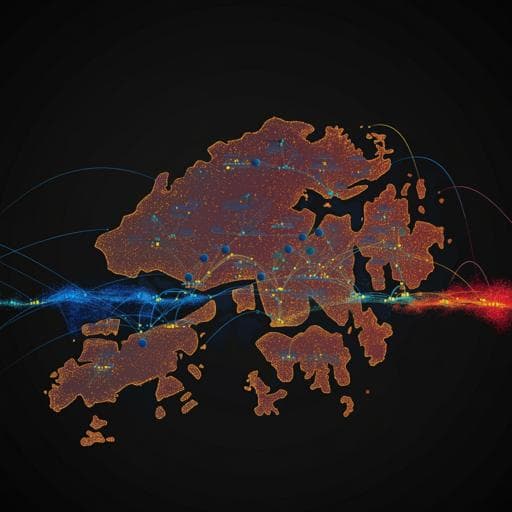
Transportation
Residential and experienced social segregation: the roles of different transport modes, metro extensions, and longitudinal changes in Hong Kong
B. P. Y. Loo, Z. Fan, et al.
This research by Becky P. Y. Loo, Zhuangyuan Fan, and Esteban Moro delves into the evolution of social segregation in Hong Kong over two decades. It uncovers how public transport, especially buses and the metro, plays a crucial role in enhancing social mixing, despite evident inequalities among income groups and a selection bias in metro station placements.
~3 min • Beginner • English
Introduction
The study confronts the long-standing urban challenge of social segregation, which persists despite cities’ density and diversity. Traditional research has focused on residential segregation, overlooking that people spend substantial time outside the home. Recent activity-space approaches reveal segregation in daily encounters, echoing the uncertain geographic context problem. In high-density Hong Kong, the authors examine how experienced social segregation relates to mobility, transport modes, and major transport infrastructure over time. They formulate four hypotheses: H1: vulnerable groups (by income, age, etc.) experience greater segregation; H2: different transport modes are associated with different levels of social mixing; H3: metro (MTR) extensions encourage more social mixing; H4: social mixing declines over decades, with daytime (activity-space) declines slower than nighttime (residential). The purpose is to quantify individual- and place-level social mixing, identify transport mode effects, assess MTR expansion impacts, and trace longitudinal changes from 1992 to 2011.
Literature Review
The review highlights a shift from residence-based to activity-based segregation metrics using mobile phone records, transit cards, and social media to quantify exposure to different socio-economic groups. Metrics include experienced isolation, experienced segregation/diversity, and exposure segregation. While mobile data enable scale, they often lack detailed individual socio-demographics and struggle in dense mixed-use environments. Travel surveys provide richer individual attributes, supporting activity-based segregation analyses in various contexts (e.g., Netherlands, Paris). The literature shows experienced segregation correlates with residential segregation and that structural inequalities persist across age, income, and life stage; vulnerable groups often face greater exposure to poverty. Urban amenities can alleviate or exacerbate segregation. Transport’s role is mixed: public transit can reduce isolation and support employment, but accessibility inequalities and transit-induced gentrification may worsen disparities. The identified gaps motivating this work are: limited evidence on how specific transport modes relate to social mixing; lack of longitudinal analyses over decades; and insufficient causal assessment of major infrastructure (e.g., metro extensions) on experienced and residential segregation in dense Asian cities.
Methodology
Data: The study uses Hong Kong Travel Characteristics Surveys (TCS) for 1992, 2002, and 2011, including detailed trip diaries with modes and socio-demographics. Sample sizes: 77,271 (1992), 92,520 (2002), 101,385 (2011). Each participant reports gender, age, household income (binned, mapped to quintiles), vehicle ownership, home location (SB level in 2002/2011; coarser traffic zones in 1992). Trips include main and leg-level modes (walking, private car, MTR, ferry, bus, taxi, SPB, PLB, etc.), with expansion factors to match census totals. Place data include Points of Interest (POIs) aggregated into seven categories (food, accommodation, finance, retail, health, education, recreation) and urban functional areas (Suburbs, New Towns, Urban Core+CBD). MTR network extension history (stations built 2002–2011) is used to define treatment/catchment buffers.
Spatial units: Analyses use planning units (Street Blocks, SB; Tertiary Planning Units, TPU) and regular H3 hex grids (Levels 7/8/9). Trips originally at SB level are interpolated to H3 hexagons by area-weighted overlap, considering only built-up areas.
Indices: Individual daytime (mobility-based) social mixing DM_i measures evenness of a person’s exposure to five income groups across visited places: DM_i = 1 − Σ_q |τ_iq − 1/5|, where τ_iq = Σ_a τ_ia τ_aq; τ_ia is an individual’s share of visits (or time) to place a; τ_aq is place a’s share of visits by income group q. Individuals who stayed home only are excluded. A social extroversion indicator flags visits to places where one’s own or adjacent income group constitutes less than a threshold (default 20%) of visitors; robustness uses 30%/40% thresholds.
Place-based daytime mixing DM_a: DM_a = 1 − Σ_q |v_qa − 1/5|, where v_qa is the total weighted visits from income group q to unit a (excluding home). Nighttime (residential) mixing NM_a at home SB is NM_a = 1 − Σ_q P_qa^2, where P_qa is the share of residents in income group q.
Mode–mixing models (place level): Cross-sectional regressions estimate association of mode-specific trip legs with DM: (5) DM_m = γ·LTrips_m (per mode); (6) DM = β1·LPop + β2·LTotalT + γ·LTrips_m + α·POI; and (7) adds functional area dummies. Longitudinal model (8) uses changes 2011–2002: ΔDM = β1·ΔLPop + β2·ΔLTotalT + γ·ΔLTrips_m + POI + Function.
Mode–mixing models (individual level): Regress individual DM on demographics (income quintile, age, gender), mode shares (proportion of trip legs by mode), and mobility metrics: total trip legs (L) and activity space size/perimeter (A) from convex hull of visited SB centroids. Variants: (10) DM = β2·Mode; (11) DM = β3·Mobility; (12) DM = β1·Demographics + β2·Mode; (13) adds Mobility. Transport opportunity controls indicate car ownership, proximity to bus stop (≤800 m), and proximity to MTR (≤1000 m).
MTR extension evaluation (H3): Spatial units are grouped by distance to stations built 2002–2011: inner ring (≤1000 m), outer ring (1000–2000 m); and analogous rings for pre-2002 stations; “No MTR” are outside 2000 m. Difference-in-differences (DiD) estimates MTR effects on DM controlling for general trends, population, and changes in trips by MTR, bus, and car. Residential composition changes are tested via Chi-square across the five groups to detect redistribution by income. Individual-level DiD mirrors place-level grouping, controlling for demographics. An instrumental variables (indirect least squares) approach uses residence within new-station catchments as an instrument to estimate the effect of increased MTR trips on individual DM.
Longitudinal analysis (H4): Using 1992, 2002, 2011 TCS, compute individual DM and residential NM over two decades. Due to coarser 1992 zones, comparisons use larger H3 scale (Level 7) for temporal consistency. Trends are examined overall and by income, age, gender, and main trip purpose.
Key Findings
- Experienced segregation persists across groups and time: Individuals from vulnerable groups (lowest income, teens, older adults) exhibit lower daytime social mixing, confirming H1.
- Day vs night: Territory-wide averages (2011) show DM ≈ 83.7% versus NM ≈ 54.4%, indicating much greater daytime exposure than residential mixing. The distribution of individual DM is significantly non-random (t = −111.6, p < 0.0001).
- Social extroversion: 34% of individuals are social extroverts (spending more time where their income group is not the majority) vs 66% introverts.
- Age gradient: Daytime mixing increases through youth into young adulthood then declines; people >65 have ≈3.2% lower DM than ages 18–35 (p < 0.0001).
- Income disparities: Lowest income group has lower daytime mixing; in 2011 they experienced 1.4% less DM than income group 4 (t = −11.88, p < 0.0001). At night, the lowest and highest income groups are the most segregated residentially across decades.
- Trip purpose: Individuals with non-home-based trips are most socially mixed; those mainly doing home-based-school trips have the lowest DM, consistent with residence-based school allocation effects.
- Place-level mode effects (cross-sectional with controls): After controlling for density (population, total trips), POIs, and function, more bus, MTR, and walking trips are positively associated with DM; taxi association vanishes or turns negative; car trips are negatively associated. Magnitudes: +1% bus trips ≈ +2.8% DM; +1% MTR ≈ +2.0% DM; +1% walking ≈ +1.4% DM. Increased taxi trips negatively relate to DM; car trips reduce DM.
- POIs and function: Food and health POIs have the strongest positive associations with both daytime and nighttime mixing (roughly 1.4–2.1% increases in DM/NM per +1% POI count). New Towns have the highest place mixing; Suburbs are ≈4.4% less diverse and Urban Core ≈2.4% less diverse than New Towns during daytime; at night, Urban Core is ≈4.1% less diverse than New Towns.
- Place-level mode effects (longitudinal, 2002–2011): Increases in bus and MTR trips are associated with increases in DM; increases in taxi trips are associated with decreases in DM.
- Individual-level mode effects: More MTR and bus use correlates with higher individual DM; ferry and tram show smaller positive effects; walking and cycling not as effective at the individual level; taxi and private car use are negatively associated. Greater mobility (more trip legs and larger activity space) increases DM.
- MTR extension—place level: DiD indicates new stations increased daytime DM by about 5–6% after controlling for changes in trips and population, with negligible effect on residential NM. However, areas chosen for extension already had higher DM (+4.9%) and NM (+11.4%) before expansion, indicating selection bias.
- MTR extension—residential composition: Chi-square tests show significant redistribution by income (p < 0.01). Inner-ring areas around new stations saw fewer low-income residents than expected (indicative of gentrification) and more higher-income residents (group 4) than expected.
- MTR extension—individual level and IV: Residents near new stations travel farther, increase MTR use, decrease bus use, and reduce unique trip legs. Instrumental-variable estimates suggest a +1% increase in MTR trips is associated with a +0.13% increase in individual DM on average.
- Long-term trends (1992–2011): Daytime DM remains higher than NM throughout but shows a slight downward trend; NM peaks in 2002 then declines, aligning with the slowdown in public housing provision. Lower-income groups had higher DM in 1992 than in 2002/2011. Gender differences in DM narrowed over time; employment-based main purpose became more mixed, while home-based purposes became less mixed; age-group variability in DM increased.
Discussion
Findings confirm that activity-space segregation mirrors and extends residential segregation in a dense city context, reinforcing the uncertain geographic context problem. Vulnerable groups—especially the lowest income, teenagers, and older adults—experience less diverse daytime encounters, implying fewer opportunities to build social capital linked to long-term outcomes. Transport systems play a moderating role: public transit (bus and MTR) is consistently associated with greater place- and individual-level social mixing, and increased transit usage over time raises mixing. Yet rail expansion exhibits place-selection bias—new stations were sited in already diverse areas—and correlates with a decline in nearby low-income residents, consistent with gentrification pressures. Thus, while MTR expansion enhances daytime mixing, it may not improve nighttime residential diversity and can alter local socio-economic composition. Walkability enhances place-level mixing but individuals who primarily walk may have smaller activity spaces and thus lower individual-level exposure, suggesting that hyper-local living can trade off with social diversity. Policy implications include targeting equitable transit investments and fare incentives for vulnerable groups, safeguarding affordable housing near new transit, and leveraging amenities (food, health, education, recreation) that draw diverse visitors to support social mixing.
Conclusion
Using three waves of Hong Kong’s TCS data (1992–2011), the study demonstrates that public transit moderates experienced social segregation and that buses and MTR are key drivers of social mixing. It quantifies individual- and place-level mixing, isolates transport mode associations cross-sectionally and longitudinally, and evaluates MTR expansion impacts with DiD and IV approaches. Despite improvements in daytime mixing associated with transit, vulnerable groups remain less exposed to socio-economic diversity, and MTR expansion areas show signs of gentrification without gains in residential mixing. The work underscores the value of human mobility data for segregation research over time. Future research should evaluate comparable dynamics in lower-access, lower-density contexts, incorporate concurrent infrastructure changes, and design policies that couple transit investments with protections and incentives (e.g., affordable housing, targeted fare policies) to ensure inclusive social mixing.
Limitations
- Survey comparability over time: Potential systematic differences in survey design and spatial reporting (1992 zones are larger/coarser than 2002/2011 SB-level), affecting longitudinal comparability and necessitating scale adjustments.
- Confounding infrastructure changes: Concurrent transport or land-use changes beyond MTR extensions were not fully identified or controlled, which may confound DiD estimates.
- Generalizability: Hong Kong’s very high density and exceptional transit accessibility (≈98.8%) differ from many cities; mode effects and mixing patterns may not transfer directly to lower-access contexts.
- Selection bias in infrastructure siting: New MTR stations were placed in already mixed areas, complicating causal attribution of gains in daytime mixing and highlighting the need to address place-selection in planning evaluations.
- Data access: Detailed TCS microdata are restricted under NDA, limiting external replication (aggregated data are shared).
Related Publications
Explore these studies to deepen your understanding of the subject.







